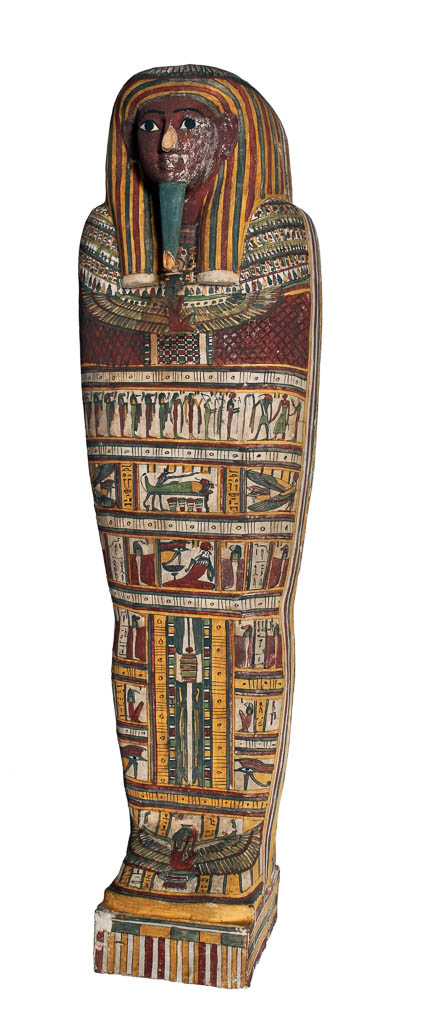Look and Think activities should take 5 -10 minutes.
Do activities might take longer depending on the task and how creative you are feeling!
Look
This coffin set has been decorated with ancient Egyptian gods, goddesses and hieroglyphic symbols.
Can you spot the figure of the jackal-headed god Anubis?
Think
Look carefully at how the coffins have been painted and zoom in on some of the details.
Can you see anywhere that the artist has not been careful?
The blue in particular is uneven.
Why do you think the blue paint might be different to the other colours?
Do
Follow these easy steps to make your own Egyptian neckpiece.

Can you spot the figure of the jackal-headed god Anubis?
Anubis was the god who looked after the dead. You can see him reaching (a very long arm) over Pakepu’s body in the centre of the coffin. Underneath him are 4 canopic jars, for storing his internal organs.
Can you see anywhere the artist has not been careful? Why do you think the blue paint could be different to the other colours?
It could be because the artist isn’t very skilful, and that would suggest that the coffins were not “top of the range” but made more cheaply. All the paint is quite carelessly applied and the blue, in particular, is quite uneven. In comparison to the other colours, the blue is a man-made colour, known as “Egyptian blue”. It is made up of a ground up glass-like substance, which didn’t mix very well with the binder in the paint and so didn’t stick very well unless it was carefully applied.
Around the base of the feet, you can also see some drip marks from the paint running down the coffin.
Follow the easy steps in this video to make your own Ancient Egyptian neckpiece:
You will need
Coloured scrap materials
Card or paper plate
Scissors
Sellotape or glue
String or ribbon for tying
Step 1
Make a semi-circle out of card or a paper plate
Step 2
Decorate with shapes, pictures and patterns inspired by Pakepu’s coffin set
Step 3
Carefully make a hole on each side of the top edge
Step 4
Measure a piece of string or ribbon to tie it to your neck piece
Step 5
Ta Da! Your own ancient-style bling!
According to Helen Strudwick Associate Curator (Ancient Egypt), this wooden coffin set which belonged to a man called Pakepu, was made to fit one inside the other. They were presented as a gift to the Fitzwilliam Museum in 1869 by the future King Edward VII. They were said to come from Thebes, the ancient site at Luxor, which is about 450 miles south of Cairo.
Pakepu is described on his coffins as a “water pourer on the West of Thebes”. This means he was a person who could be employed by families to maintain the funerary cults of their dead relatives. He would have been expected to visit their tombs on the west bank of the Nile and perform rituals there, including pouring water for the dead. On the basis of the style of the coffin and its decoration, we believe Pakepu’s coffins were made about 680–665 BC. This would mean that he lived during a period when Egypt was ruled by Nubians from northern Sudan.
You can find out more about Pakepu’s coffin set on the Ancient Egyptian Coffins Project website.
Download this Look Think Do as a PDF or a Word document.